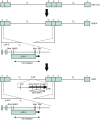Herpes simplex virus oncolytic therapy for pediatric malignancies
- PMID: 19367259
- PMCID: PMC2835221
- DOI: 10.1038/mt.2009.73
Herpes simplex virus oncolytic therapy for pediatric malignancies
Abstract
Despite improving survival rates for children with cancer, a subset of patients exist with disease resistant to traditional therapies such as surgery, chemotherapy, and radiation. These patients require newer, targeted treatments used alone or in combination with more traditional approaches. Oncolytic herpes simplex virus (HSV) is one of these newer therapies that offer promise for several difficult to treat pediatric malignancies. The potential benefit of HSV therapy in pediatric solid tumors including brain tumors, neuroblastomas, and sarcomas is reviewed along with the many challenges that need to be addressed prior to moving oncolytic HSV therapy from the laboratory to the beside in the pediatric population.
Figures



Similar articles
-
Design and Rationale for First-in-Human Phase 1 Immunovirotherapy Clinical Trial of Oncolytic HSV G207 to Treat Malignant Pediatric Cerebellar Brain Tumors.Hum Gene Ther. 2020 Oct;31(19-20):1132-1139. doi: 10.1089/hum.2020.101. Epub 2020 Aug 17. Hum Gene Ther. 2020. PMID: 32657154 Free PMC article.
-
Preclinical evaluation of engineered oncolytic herpes simplex virus for the treatment of neuroblastoma.PLoS One. 2013 Oct 10;8(10):e77753. doi: 10.1371/journal.pone.0077753. eCollection 2013. PLoS One. 2013. PMID: 24130898 Free PMC article.
-
The Current Landscape of Oncolytic Herpes Simplex Viruses as Novel Therapies for Brain Malignancies.Viruses. 2021 Jun 17;13(6):1158. doi: 10.3390/v13061158. Viruses. 2021. PMID: 34204248 Free PMC article. Review.
-
Combinatorial strategies for oncolytic herpes simplex virus therapy of brain tumors.CNS Oncol. 2013 Mar;2(2):129-42. doi: 10.2217/cns.12.42. CNS Oncol. 2013. PMID: 23687568 Free PMC article. Review.
-
Oncolytic herpes simplex virus therapy for peripheral nerve tumors.Neurosurg Focus. 2007 Jun 15;22(6):E4. doi: 10.3171/foc.2007.22.6.5. Neurosurg Focus. 2007. PMID: 17613221 Review.
Cited by
-
Immunovirotherapy for the Treatment of Glioblastoma and Other Malignant Gliomas.Neurosurg Clin N Am. 2021 Apr;32(2):265-281. doi: 10.1016/j.nec.2020.12.008. Epub 2021 Feb 18. Neurosurg Clin N Am. 2021. PMID: 33781507 Free PMC article. Review.
-
Stability and anti-tumor effect of oncolytic herpes simplex virus type 2.Oncotarget. 2018 May 15;9(37):24672-24683. doi: 10.18632/oncotarget.25122. eCollection 2018 May 15. Oncotarget. 2018. PMID: 29872496 Free PMC article.
-
Cancer Stem Cells and Pediatric Solid Tumors.Cancers (Basel). 2011 Jan 14;3(1):298-318. doi: 10.3390/cancers3010298. Cancers (Basel). 2011. PMID: 21394230 Free PMC article.
-
Phase I/II study of oncolytic herpes simplex virus NV1020 in patients with extensively pretreated refractory colorectal cancer metastatic to the liver.Hum Gene Ther. 2010 Sep;21(9):1119-28. doi: 10.1089/hum.2010.020. Hum Gene Ther. 2010. PMID: 20486770 Free PMC article. Clinical Trial.
-
Oncolytic effects of parvovirus H-1 in medulloblastoma are associated with repression of master regulators of early neurogenesis.Int J Cancer. 2014 Feb 1;134(3):703-16. doi: 10.1002/ijc.28386. Epub 2013 Sep 2. Int J Cancer. 2014. PMID: 23852775 Free PMC article.
References
-
- Gatta G, Capocaccia R, Coleman MP, Ries LA., and , Berrino F. Childhood cancer survival in Europe and the United States. Cancer. 2002;95:1767–1772. - PubMed
-
- Ries LAG, Melbert D, Krapcho M, Mariotto A, Miller BA, Feuer EJ.SEER Cancer Statistics Review, 1975-2004, National Cancer Institute Bethesda, MD; et aleds < http://seer.cancer.gov/csr/1975_2004/ >, based on November 2006 SEER data submission, posted to the SEER Web site, 2007
-
- Markert JM, Parker JN, Gillespie GY., and , Whitley RJ. Genetically engineered human herpes simplex virus in the treatment of brain tumours. Herpes. 2001;8:17–22. - PubMed
-
- Shah AC, Benos D, Gillespie GY., and , Markert JM. Oncolytic viruses: clinical applications as vectors for the treatment of malignant gliomas. J Neurooncol. 2003;65:203–226. - PubMed
-
- Bharatan NS, Currier MA., and , Cripe TP. Differential susceptibility of pediatric sarcoma cells to oncolysis by conditionally replication-competent herpes simplex viruses. J Pediatr Hematol Oncol. 2002;24:447–453. - PubMed
Publication types
MeSH terms
Grants and funding
LinkOut - more resources
Full Text Sources
Other Literature Sources

